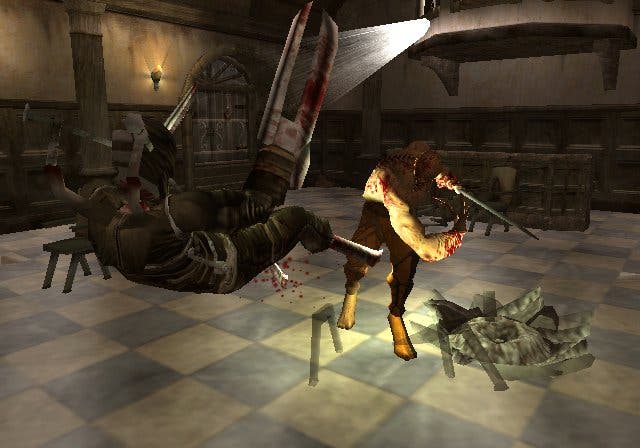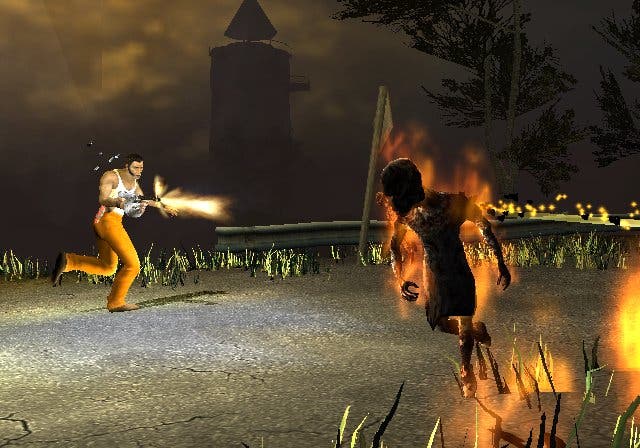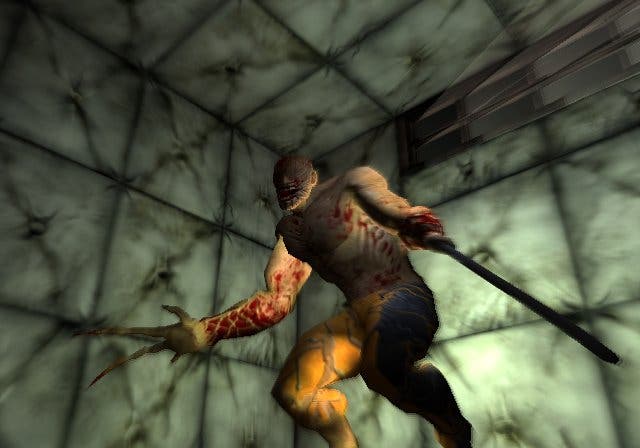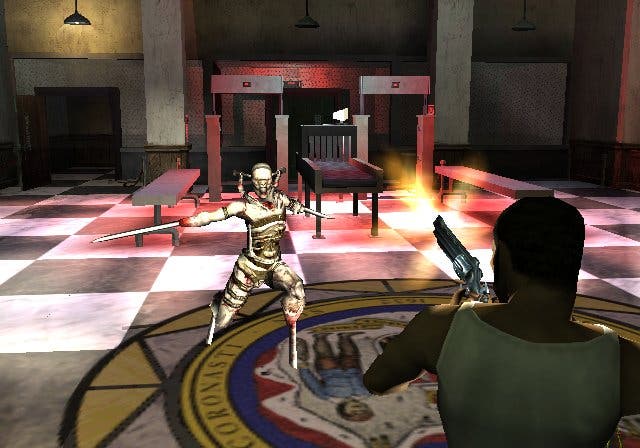The Suffering
A Midway game called The Suffering. It should be awful, right?
Although The Suffering will inevitably wind up lumped with Resident Evil and Silent Hill in the 'survival horror' category, in actual fact it feels more like an 'action horror' title when you get round to playing it. In games like Resident Evil, risking the last half an hour's play every time you take an uncertain step arguably does just as much to promote tension and accentuate every fright as a mutant dog leaping through a window. And while The Suffering is heavy on the otherworldly sights and sounds, it dispenses with the slower pacing and inventory juggling of 'survival horror' titles and throws in a pretty comfortable checkpoint system to boot. A good idea, or a bad one? Well, it's a Midway game called "The Suffering", and we haven't made the obvious joke yet, so the signs are fairly encouraging...
Alone in the dark

It certainly begins with a bang. The opening sequence shows your character, Torque, being delivered to his cell on death row at Abbott State Penitentiary, the architect of a murdered wife and two children drowned and tossed out of an upstairs window - at least according to the profanity-ridden buzz permeating the jailhouse. Once you're installed though, things take a turn for the worse (and, remember, that's 'worse than sitting on death row waiting to die for a crime you don't remember committing') as the lights go out, and what feels like an earthquake hits the jail. All of a sudden, people start dying in the shadows at the hands of a little-seen but horrendously violent adversary, and you start hearing whispers in the dark, hallucinating death scenes and witnessing flashes of putrid and jarringly demonic imagery, which pop up on screen with a pang of sound as if they're jumping to mind at the whim of some outside force.
You start making your way through the crumbling buildings, the darkened hallways of the prison, the shower rooms and past execution chambers and other Cell Blocks, guiding yourself through the darkest areas with a limited-battery flashlight, kicking in doors you can open, and gradually encountering more and more horrible enemies, most of whom you can hear before you see.
Coupled with eerie scenes of dismembered corpses, guards crucified with lethal injection needles, torsos hanging from ropes, and seemingly endless trails of blood, the eerily suspenseful atmosphere is enough to keep your heart pumping faster than usual, and that's before you start glancing at scenes on the other side of CCTV monitors, encountering undead remnants of the demonic experimentation that took place in the bowels of Abbott many years ago, and paying attention to the voices in your head - one from your dead wife, and one from the heart of pure evil...
Assault on Cell Block H

Sadly though, this unnerving opener doesn't last, and the game soon slips into a basic pattern, splitting up fairly straightforward progression through shoot-'em-up action sequences (using pistols, tommy guns, shotguns, grenades and so on) with the odd well-paced fright or hallucinatory encounter with your battered family and other horrors, flashes of demonic imagery, and the occasional basic puzzle (like having to block drains so that water can build up and extinguish a fire blocking the next doorway, or swinging a rock with a crane so it knocks something over).
The combat sequences, of which there are many, basically rely on having lots of enemies to kill, rather than having a choice selection of very difficult or fast-moving ones. There's certainly no moment of desperation equal to Resi or Silent Hill's set pieces; nothing comparable to finding yourself trapped at a dead end with a zombie looming up behind you, or sitting in a train and having to dodge tentacles as they smash through from the outside. And as a result the game quickly sacrifices the impact of its otherwise horrific enemies, which start off by creeping up on you in the dark, leaping between ground and ceiling, the telltale clink-clink-clink of their bladed legs on concrete the only indicator in darkened rooms; instead preferring to try and bring you down as a group, and becoming obstacles rather than architects of true horror as a result.
Save the early moments, and a couple of occasions in the dark when you run out of flashlight batteries and run low on health, enemies don't cause enough problems individually to actually concern you. You certainly wouldn't compare the sight of a couple of Quake 2 Tank-style projectile shooting enemies with some of the moments in Resident Evil - there's nothing here that comes close to pressing a button and seeing a door seal shut beside you, just as the gates are lifted on a couple of darkened holes and fiendish, dog-like monsters come running out, snarling and arcing towards your jugular vein to splatter your guts everywhere and destroy the last 20 minutes work. Instead we have small green radioactive-looking nasties who toss needles at you, enemies that burrow under the ground and occasionally pop up and swing hooks at you, and the odd demon that drops down from the ceiling and hauls you away...
The omens...

It sounds more like Half-Life's version of fear than a survival horror game. And if you do go down that route, you realise that while there are plenty of survival horror trappings, shoot-'em-ups like HL certainly had a big influence. For a start, the game is ostensibly linear and played from the traditional third or first person views (and thusly shooting enemies involves lining up a crosshair with the twin sticks and hammering the fire button). It also relies on scripted sequences to add some energy to the decaying prison, there are plenty of windows into another, horrific world, and there are even NPCs eager to tag along, giving you a choice between offering help (to the delight of your dead wife's soothing voiceover) or mutilating them horribly (much to the gratification of the demon in your head). In fact, your behaviour towards others - whether you choose to press a button releasing a bunch of convicts trapped in a blazing Cell Block, for example, and whether you let a guard out of a gas chamber as the demons flick the switch - ultimately influences the outcome of the game.
In trying to mix horror and action though, The Suffering sets itself up for failure, arguably settling for completely the wrong balance - a myriad slightly spooky enemies, repetitive action sequences, the regular sight of a hut full of weapons and ammo, contrived and convoluted progression, and the occasional moment of actual fear. You may be compelled by the story, but otherwise you're relying on falling for the action - and for the most part we didn't.
You see, for the most part you just pick off samey enemies from a distance with projectile weapons, occasionally harnessing Torque's "insanity meter" and becoming one of the beasts, ravaging enemies with blades that catch them like meat on a skewer and splatter them everywhere, and changing back before the meter runs dry. But even this is generally unnecessary, and once you shake off the anxiety you've been trained to associate with survival horror and just get on with it, it becomes something of a slog.
It's good to Torque

Chances are you'll shake that feeling off completely when you first realise that although the other prisoners and guards seem to be in danger of dying horribly at any given moment, hauled up into the rafters by brain-chewing zombies, cut in half by demonic blades or shot to pieces by increasingly unhinged guards, Torque stands very little chance of meeting the same fate. If you die, it's because you're overwhelmed, out of ammo or out of flashlight batteries, and it really isn't the end of the world to have to pick up from a couple of minutes prior.
To be fair though, The Suffering is more than worthy of a lot of praise. There are some genuinely disconcerting moments, an interesting story of demonic misadventure, some fairly ghastly sights and sounds, and some genuinely standout frights - like flicking through CCTV monitors, happening upon the view of yourself from above and behind, and suddenly seeing a figure looming up behind you, only to exit, whirl round and find nothing there. It's also quite effective in the execution of the narrative - Torque keeps his mouth shut throughout, leaving you to ponder the gravity of the situation and your own morality, and as a result it feels more like your own adventure rather than somebody else's, which is something other survival horror games sometimes get wrong...
Certainly it's been well designed in places. Anybody who thinks claret makes a horror game will appreciate the way Torque gets increasingly blood-splattered, and anybody with more than half a Resident Evil adventure behind them will appreciate the lack of third-person camera or control issues (granted, Torque can be a bit awkward about climbing objects, but that's hardly a turn-and-then-walk control scheme on the scale of irritating features). And in fact just about everybody will appreciate the way the developer builds up an atmosphere, using well-acted voice roles (both demonic and not), outbursts of fear and profanity and the creepy whisperings and otherworldly sounds, all of which add to the claustrophobia and the sense of a world about to spiral into true terror.
We're going suffering
What it comes down to though is more of a question of whether it's actually scary, and if not, why not? As it is, The Suffering has some scary moments, but for the most part they punctuate a fairly regular albeit twisted action game, rather than driving it. Compare it to Resident Evil and you realise that a lot of the things you cursed - the irregular save spots, new and overwhelming horrors setting you back a distance, enemies crawling in through the windows to occupy older sections you'll need to revisit, and the lack of support and munitions - were just as important to the atmosphere of fear and horror as the moments of humour and calm before the storm, the cut sequences, the monstrous adversaries, and the claustrophobic camera angles. And as you race into another area in The Suffering and hammer the fire button until your finger blisters, you'll realise you miss them.
It's a shame, because The Suffering could have been great. We're not asking for a carbon copy of Resident Evil or Silent Hill, but with a little more consideration, Surreal could have remoulded the experience a lot more effectively. As it is though, it's a good, solid, disquieting action game that ought to serve fans of the macabre and whodunnit-with-demons perfectly adequately, but stands little chance of threatening the crowns of the Silent Hills, Resident Evils and Project Zeros of this and other worlds. In other words its flaws are perfectly sufferable, which is a lot better than we had any right to expect, and if this is a sign of what we can expect from the new-look Midway, we're all for it.








